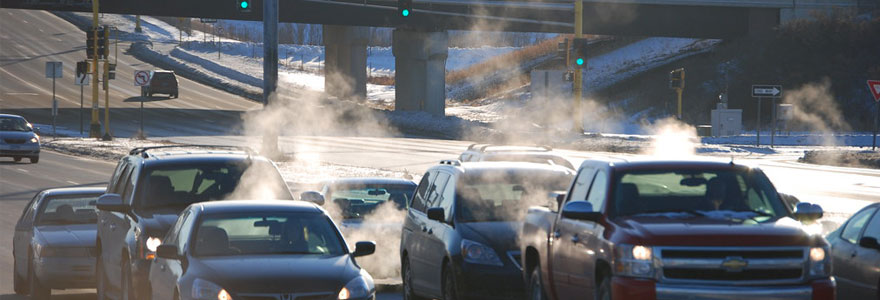News and Updates
Contact
Faculty of Social Science
Social Science Centre
Room 9438
Western University
T. 519-661-2053
F. 519-661-3868
E. social-science@uwo.ca
COVID-19 shutdown allows researchers to better measure urban heat islands
January 24, 2022
Cars on a street in winter produce exhaust; cars, along with other human activity, inject heat into urban environments, a process called anthropogenic heat flux - photo by Kent Landerholm
Story by Rob Rombouts
Cities create and capture heat, and new research with connections to Western sheds light on how much of that is related directly to human activity.
Researchers have known about ‘urban heat islands’ since the late mid-19th century, as urban areas can have a difference in temperature of more than a degree compared to their surroundings. Pinpointing the exact cause of urban heat islands is a bit more difficult. When COVID-19 led to a shutdown in cities around the world, it provided an opportunity for researchers to measure the effects of human activities.
The results of this research were recently released in a journal article. James Voogt, professor in the Department of Geography and Environment, was a co-author on the paper, and two of the co-authors on the paper, Wenfeng Zhan and Jinling Quan, were previously visiting graduate students at Western.
When cities are built, roads and buildings replace vegetation and water-absorbing surfaces are replaced with more impervious surfaces that dry and heat-up faster. Cities will also have more differences in height, creating a ‘rougher’ surface, which will trap more sunlight and slow cooling at night. The materials that make up roads and buildings also generally hold more heat than the natural landscape.
These changes all contribute to cities having different climates than their surrounding areas, often, but not always, being warmer. The concentration of human population also contributes to these differences. Human activities – such as heating and cooling buildings, traffic, the use of electricity and industrial processes – inject heat, a process called anthropogenic heat flux. The impact of this heat flux is spatially variable, depending on population density, and land use, as well as climatically and seasonally variable, said Voogt. There are even differences within a day, with anthropogenic heat fluxes peaking in the morning and evening and decreasing overnight.
Relying on a system of sensors monitoring air temperatures in more than 300-plus megacities in China, as well as remotely sensed surface temperatures from satellite imagery, the researchers compared temperatures in urban settings from January to April 2017, to those of January to April 2020. The results showed that the reduction of human activity caused by COVID related shutdowns led to a decrease in air temperatures of around half a degree Celsius with surface temperature decreases about half that amount. Normally, it is difficult to attribute how much of the heat difference in cities is due to anthropogenic heat flux.
“The COVID related shutdowns provide a rare opportunity to assess the impact of anthropogenic heat fluxes on urban temperatures. The contribution of these heat fluxes to urban warming is typically mixed with warming from other factors and the anthropogenic heat fluxes themselves are very difficult to measure accurately,” said Voogt. “The COVID shutdown provided the unusual opportunity to directly measure the impact on temperatures that are associated with the change in only one factor, anthropogenic heat fluxes.”
The study showed the heat island decreased by over a third during this period – which indicates a large relative contribution from urban activities to the overall urban warming for that time period. The heat changes in cities, Voogt said, are different, and above, the heat changes caused by climate change. The extra heat, however, may make it more difficult for people in cities to adjust to changes, particularly in locations where summer conditions warm beyond the human comfort range.
“In many cities, heat is already becoming a major issue,” said Voogt. “Heat events are already the most likely severe weather event to kill people, although until recently, people often weren’t categorized as dying from heat.” With more than half the world’s population already living in cities, and this proportion increasing, this issue will become increasingly important.
“Changing human behaviour is different than changing design and structure of a city,” said Voogt. The challenges of responding to urban heat also reflects equity and racial issues, including who has access to cooling, which parts of the cities have trees, and who is exposed to more heat, said Voogt.
The research, Voogt said, underscores the importance of cities as an environment to study.
“Human activity is generating heat at multiple scales,” said Voogt. “Cities are receptors of these factors. They are sensitive environments and are home to a lot of people. Urban areas are already warmer than their surroundings and, and cities will have large scale climate change superimposed on top of that.”

